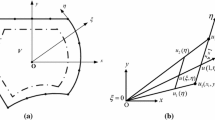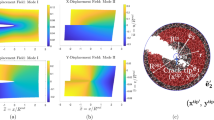Summary
In the current investigation we seek to identify the underlying crack number and crack length distributions in brittle plates with a known strength distribution. The inverse problem in probabilistic fracture mechanics is defined, and the numerical procedure to solve the inverse problem is constructed. The simulation process of generating simulated plates containing simulated random cracks is elaborated. The maximum strain energy release rate criterion (G max) is applied to each simulated random crack to find the crack strength. The strength of the simulated plate is equated to the strength of the weakest simulated crack in the plate based on the weakest link notion. The underlying crack number and crack length distributions are obtained by minimizing the difference between the simulated plate strengths and the known plate strengths. The gamma, lognormal and two-parameter Weibull distributions are employed for the underlying crack length distribution, and are compared in order to identify the best choice. Numerical examples demonstrate that the three PDFs are all acceptable for reasons to be explained. In the appendix, the direct problem in probabilistic fracture mechanics is presented as part of the demonstration of a method for using the crack distribution identified in the inverse problem to predict the strength and the probability of fracture in a practical application.
Similar content being viewed by others
References
Jayatilaka, A. De S., Trustrum, K.: Statistical approach to brittle fracture. J. Material Sci.12, 1426–1430 (1977).
Jayatilaka, A. De S., Trustrum, K.: Application of a statistical method to brittle fracture in biaxial loading systems. J. Material Sci.12, 2043–2048 (1977).
Nicholson, D. W., Ni, P.: Extreme value probabilistic theory for mixed-mode brittle fracture. Engng. Fract. Mech.58, 121–132 (1977).
Ahn, Y., Nicholson, D. W.: Probabilistic theory of mixed-mode fracture in brittle plates with random cracks. Proc. Int. Conf. Fracture and Damage Mech. (M. Aliabadi, ed). University of London 1999.
Ahn, Y., Nicholson, D. W.: Probabilistic theory of fracture in brittle plates with random cracks, including scatter inK IC. Submitted for publication.
Ni, P.: Probabilistic theory for mixed-mode brittle fracture and fatigue with random cracks, Ph. D. Dissertation, University of Central Florida 1996.
Sih, G. C.: Strain energy density factor applied to mixed mode crack problems. Int. J. Fract.10, 305–321 (1974)
Shi, G. C., Macdonald, B.: Fracture mechanics applied to engineering problems — Strain energy density criterion. Engng. Fract. Mech.6, 361–386 (1974).
Hudak, S. J., et al.: A. comparison of single-cycle versus multiple-cycle proof testing strategies. NASA Contractor Report No. 4318, Washington D. C., 1990.
Harris, D. O.: Probabilistic fracture mechanics. In: Probabilistic structural mechanics handbook (C. Sundararajan, ed.). New York: Chapman and Hall 1995.
Ichikawa, M., Tanaka, S.: A critical analysis of the relationship between the energy release rate and the stress intensity factors for non-coplanar crack extension under combined mode loading. Int. J. Fract.18, 19–28 (1982).
Ahn, Y., Nicholson, D. W.: Mixed-mode fracture by maximum strain energy release rate criterion, In: Proc. 1st Canadian Conference on Nonlinear Solid Mechanics (Croitoro, E., ed.), Victoria, Canada, July 1999. Victoria: University of Victoria Press 1999.
Erdogan, F., Sih, G. C.: On the crack extension in plates under loading and transverse shear. ASME J. Basic Engng85, 519–527 (1963).
Mann, N. R., Schafer, R. E., Singpurwalla, N. D.: Methods for statistical analysis of reliability and life data. New York: Wiley 1974.
McClave, J. T. et al.: Statistics. New Jersey: Prentice-Hall 1997.
Knuth, D. E.: Seminumerical algorithms. New Jersey: Addison-Wesley 1981.
Press, W. H. et al.: Numerical recipes in C. Cambridge: Cambridge University Press 1988.
Author information
Authors and Affiliations
Rights and permissions
About this article
Cite this article
Ahn, Y., Nicholson, D.W., Wang, M.C. et al. Inverse method for identifying the underlying crack distribution in plates with random strengths. Acta Mechanica 144, 137–154 (2000). https://doi.org/10.1007/BF01170171
Received:
Issue Date:
DOI: https://doi.org/10.1007/BF01170171




